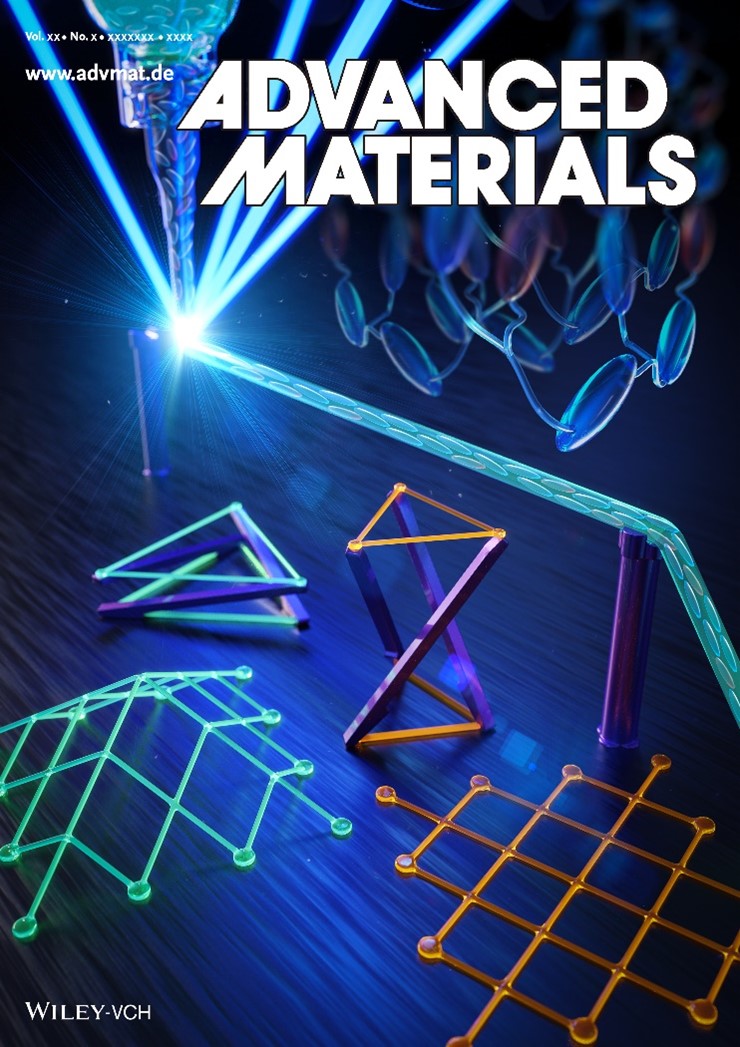Liquid crystal elastomers (LCE) are appealing candidates among active materials for 4D printing, due to their reversible, programmable, and rapid actuation capabilities. Recent progress has been made on direct ink writing (DIW) or digital light processing (DLP) to print LCEs with certain actuation. However, it remains a challenge to achieve complicated structures, such as spatial lattices with large actuation, due to the limitation of printing LCEs on the build platform or the previous layer.
In a recent work published online in Advanced Materials (selected as the inside cover), Qi Zhao, and their collaborators developed a novel hybrid additive manufacturing system that 4D prints freestanding LCE on-the-fly for 3D structures in a one-step additive process. This hybrid system consists of a top-down DLP and a DIW with an in-situ laser-curing module. The laser curing module cures the LCE ink as it is extruded and stretched by the moving nozzle, while the DLP provides optional structural or removable supports. Unlike freestanding rigid materials such as metals, rigid plastics, fiber-reinforced thermoset composites, or glasses, soft and flexible LCEs are difficult to print in the air while still retaining their shapes. Additionally, printing becomes more challenging when actuation capability is required to be kept for LCEs. To address this challenge, researchers rationally design the LCE ink and enable rapid curing upon extrusion to fix the shape and mesogen alignment. The stretching due to nozzle movement is further utilized to enhance mesogen alignment and thus actuation (up to 40% actuation strain). The team also carefully choose the photoinitiator and laser wavelength for LCE to avoid interference with DLP inks. To the best of the authors’ knowledge, this is the first report of DIW printing of freestanding active materials on-the-fly. It is further demonstrated that with this new capability, LCE-based active structures, such as hybrid lattices, active tensegrity, an actuator with tunable stability, and 3D spatial lattices can be additively fabricated.
This work was conducted by Prof. H. Jerry Qi’s group at Georgia Tech and Prof. Ruike Renee Zhao’s group at Stanford University. This research is also in collaboration with Prof. Frédéric Demoly of University Bourgogne Franche-Comté, and Prof. Kun Zhou of Nanyang Technological University. Dr. Xirui Peng and Mr. Shuai Wu contributed equally to this work. Dr. Xirui Peng was a Woodruff school Ph.D. student and just successfully defended his thesis in August 2022.
Further information on this work could be found in the recently published article entitled “4D Printing of Freestanding Liquid Crystal Elastomers via Hybrid Additive Manufacturing” in Advanced Materials (https://doi.org/10.1002/adma.202204890). And the work has been selected to be featured on the inside cover of the issue.
Peng, Xirui, Shuai Wu, Xiaohao Sun, Liang Yue, S. Macrae Montgomery, Frédéric Demoly, Kun Zhou, Ruike Renee Zhao, and H. Jerry Qi. “4D Printing of Freestanding Liquid Crystal Elastomers via Hybrid Additive Manufacturing.” Advanced Materials, 2022, 2204890.

